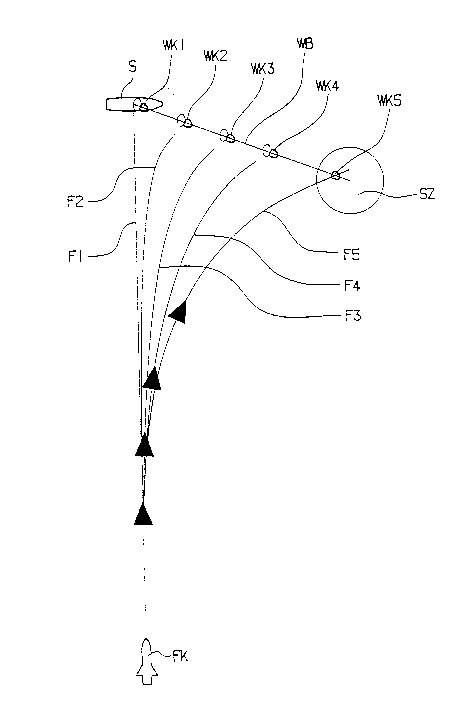Une partie des informations de ce site Web a été fournie par des sources externes. Le gouvernement du Canada n'assume aucune responsabilité concernant la précision, l'actualité ou la fiabilité des informations fournies par les sources externes. Les utilisateurs qui désirent employer cette information devraient consulter directement la source des informations. Le contenu fourni par les sources externes n'est pas assujetti aux exigences sur les langues officielles, la protection des renseignements personnels et l'accessibilité.
L'apparition de différences dans le texte et l'image des Revendications et de l'Abrégé dépend du moment auquel le document est publié. Les textes des Revendications et de l'Abrégé sont affichés :
| (12) Demande de brevet: | (11) CA 2160831 |
|---|---|
| (54) Titre français: | METHODE POUR PROTEGER DES OBJETS RAYONNANTS, LES NAVIRES PAR EXEMPLE, QUI EMETTENT PLUSIEURS RAYONNEMENTS, NOTAMMENT INFRAROUGE, CONTRE LES ATTAQUES DE MISSILES |
| (54) Titre anglais: | METHOD FOR PROTECTING OBJECTS, ESPECIALLY SHIPS, THAT EMIT A RADIATION, PARTICULARLY INFRARED RADIATION, AGAINST MISSILES |
| Statut: | Réputée abandonnée et au-delà du délai pour le rétablissement - en attente de la réponse à l’avis de communication rejetée |
| (51) Classification internationale des brevets (CIB): |
|
|---|---|
| (72) Inventeurs : |
|
| (73) Titulaires : |
|
| (71) Demandeurs : |
|
| (74) Agent: | G. RONALD BELL & ASSOCIATES |
| (74) Co-agent: | |
| (45) Délivré: | |
| (22) Date de dépôt: | 1995-10-18 |
| (41) Mise à la disponibilité du public: | 1996-04-22 |
| Licence disponible: | S.O. |
| Cédé au domaine public: | S.O. |
| (25) Langue des documents déposés: | Anglais |
| Traité de coopération en matière de brevets (PCT): | Non |
|---|
| (30) Données de priorité de la demande: | ||||||
|---|---|---|---|---|---|---|
|
A method for protecting an object such as a ship emitting radiation
against a missile equipped with an intelligent homing head for sensing the radiation
has the steps of launching a diversionary projectile body away from the object and
of dispersing the projectile body at a removed location to form a dummy target
cloud. It has the further interposed step of activating a radiation means on theprojectile body immediately after launching that body. The radiation means radiates
an energy form corresponding to the energy form from the later dummy target cloud,
and continues to radiate that energy form until the dummy target cloud has formed
and built to a sufficient level. A series of projectile bodies may be launched with a
temporal and/or spatial offset, creating a continuous diversionary radiation path.
Note : Les revendications sont présentées dans la langue officielle dans laquelle elles ont été soumises.
Note : Les descriptions sont présentées dans la langue officielle dans laquelle elles ont été soumises.

2024-08-01 : Dans le cadre de la transition vers les Brevets de nouvelle génération (BNG), la base de données sur les brevets canadiens (BDBC) contient désormais un Historique d'événement plus détaillé, qui reproduit le Journal des événements de notre nouvelle solution interne.
Veuillez noter que les événements débutant par « Inactive : » se réfèrent à des événements qui ne sont plus utilisés dans notre nouvelle solution interne.
Pour une meilleure compréhension de l'état de la demande ou brevet qui figure sur cette page, la rubrique Mise en garde , et les descriptions de Brevet , Historique d'événement , Taxes périodiques et Historique des paiements devraient être consultées.
| Description | Date |
|---|---|
| Le délai pour l'annulation est expiré | 1999-10-18 |
| Demande non rétablie avant l'échéance | 1999-10-18 |
| Réputée abandonnée - omission de répondre à un avis sur les taxes pour le maintien en état | 1998-10-19 |
| Demande publiée (accessible au public) | 1996-04-22 |
| Date d'abandonnement | Raison | Date de rétablissement |
|---|---|---|
| 1998-10-19 |
Le dernier paiement a été reçu le 1997-10-02
Avis : Si le paiement en totalité n'a pas été reçu au plus tard à la date indiquée, une taxe supplémentaire peut être imposée, soit une des taxes suivantes :
Veuillez vous référer à la page web des taxes sur les brevets de l'OPIC pour voir tous les montants actuels des taxes.
| Type de taxes | Anniversaire | Échéance | Date payée |
|---|---|---|---|
| TM (demande, 2e anniv.) - générale | 02 | 1997-10-20 | 1997-10-02 |
Les titulaires actuels et antérieures au dossier sont affichés en ordre alphabétique.
| Titulaires actuels au dossier |
|---|
| BUCK WERKE GMBH & CO. |
| Titulaires antérieures au dossier |
|---|
| NORBERT WARDECKI |